|
We all know the Swiss Army knife with knife blades, toothpick, comb, scissors and more folding out from its case. The Swiss are fairly innovative, but this is one invention that the ancient Romans might have beat them on. This example of a Roman multi-tool was used nearly 2000 years ago and discovered in an unspecified Mediterranean site. This intricate design dates from around 200 AD and is made of silver, with an obviously rusted iron knife blade. It has implements that fold out for use: knife, spoon, fork, spike, spatula and small tooth-pick. Some believe this was an eating and grooming instrument carried by Roman troops, but more than likely, because it was made of silver, it was used by a higher ranked official of the Legionnaires or possibly a political figure--definitely a wealthy Roman traveler. It is in the Greek and Roman antiquities gallery at the Fitzwilliam Museum, in Cambridge, England. --GVI Were the ancient Romans ahead of their time? The famous Lycurgus Cup in the British Museum might be proof that they were indeed very advanced in the sciences, especially in the field of Nanotechnology. The 1,600-year-old glass goblet does something very magical: It changes color from jade-green to blood-red depending on the direction of its illumination... with the light source from the front, the goblet appears green, from the rear it changes dramatically to red. This is called Dichroic behavior. The Roman craftsmen who created this work of art either knew about the science behind it, or stumbled unknowingly onto its special characteristics. As they might have put it, felix accidente, a happy accident. The Romans may have been the first to discover the colorful potential of nano-particles by accident, but they seem to have created the world's most perfect example of the phenomenon. The Artistry of the Chalice The Lycurgus Cup is also a very rare example of a Roman caged cup, or diatretum. The glass has been painstakingly cut and ground back to leave only a decorative "cage" on the surface with extreme undercutting. Instead of the more common abstract, geometric design, the Lysurgus Cup contains beautifully detailed human figures. It shows the mythical King Lycurgus, who attempted to kill Ambrosia, a follower of the god Dionysus (Bacchus). She was transformed into a vine that twined around the enraged king, killing him. Dionysus and two followers are shown taunting the king. Such figures on a caged cup are otherwise unknown. History of the Cup The Cup is thought to have been made in either Alexandria or Rome around 290-325 AD, measuring 6 1/2" x 5". Judging from its excellent condition, it more than likely was never buried and was always kept as a treasure, at first in a noble Roman's villa, then in a church and later in the collections of the elite. There is also the possibility that it was recovered from a sarcophagus. The gilt and bronze feet were added late in its life--about 1800, making some think it was looted from the church during the French Revolution. It's more than likely that earlier mounts existed, but wore away with time and use. No one really knows the earlier history of the Cup. One can ponder about who it was originally created for, perhaps an emperor? The Science Behind the Chalice: Dichroism The Lycurgus Cup was mentioned in French writings as early as the 1845, but no one knew why it changed color. The British Museum acquired the Cup in the 1950s, but it wasn't until 1990 that researchers examined small broken shards under an electron microscope and discovered the secret. Whether or not the Romans stumbled into it, the artisans were truly nanotechnology pioneers. Nano-particles of gold in the glass on a microscopic level is the reason for the color change. (Gold added to glass makes red glass, as in stained glass windows). It's unknown whether the Roman artisans impregnated the glass with particles of silver and gold on purpose, or whether the glass was somehow already "contaminated" before they used it. Researchers found particles as small as 50 nanometers in diameter, less than one-thousandth the size of a grain of salt. Some think that exact ratio of the mixture of the precious metals suggests the Romans certainly did know what they were doing. This is how the technology works: When hit with light, electrons belonging to the metal flecks reflect frequencies into our eyes in ways that alter the color depending on the observer’s position in relation to the light. Was the Lycurgus Cup a Poison Detector? During the Renaissance, the ruling class believed that goblets and glassware made on the island of Murano in the Venice lagoon would vibrate and shatter when poison was poured into them. Although false--and likely just marketing hype aimed at the ultra-rich so they would pay more for glassware--perhaps this long held notion was based in some long-distant reality... a capability of cups like the Lycurgus, perhaps? Gang Logan Liu, is an engineer at the University of Illinois at Urbana-Champaign, and has been focusing on using nanotechnology to diagnosis and treat disease. He explains, “The Romans knew how to make and use nano-particles for beautiful art. We wanted to see if this could have scientific applications.” Liu theorized that when a nano-treated vessel was filled with various liquids, the vibrating electrons would change the color of the glass according to the type of liquid used. The use the Lycurgus Cup to test his theory could never be allowed for fear of damaging a priceless Roman artifact. So he created this experiment: The scientists imprinted billions of tiny wells onto a plastic plate about the size of a postage stamp and sprayed the wells with gold or silver nano-particles, essentially creating an array with billions of ultra-miniature Lycurgus Cups. When water, oil, or sugar and salt solutions were poured into the wells, they displayed a range of easy-to-distinguish colors—light green for water and red for oil, for example. The prototype was 100 times more sensitive to altered levels of salt in solution than current commercial sensors using similar techniques. Were There Other Dichrioc Cups the Ancient World? Yes, it seems that the ruling class were well aware of them, owned them, gave them as gifts and drank from them on special occasions. However, only a handful of Roman dichroic glass objects are known to exist. Only 50 or so late Roman cage cups themselves exist, but even rarer, fewer than 10 dichroic glass objects have ever been found, and all of them (aside from the Lycurgus Cup) are mere fragments. Objects of such rarity with the extraordinary property of changing color would obviously be bought or commissioned by only privileged Romans. There are some ancient texts that discuss them... From Vopiscus' life of the third-century pretender Saturninus is a letter claimed to be written by emperor Hadrian (117–138) when he was in Egypt. Written in the early 4th century AD, Hadrian describes a gift to his brother-in-law Severianus in Rome: "I have sent you parti-colored cups that change color; presented to me by the priest of a temple. They are specially dedicated to you and to my sister. I would like you to use them at banquets on feast days" From the novel Leukippe and Cleitophon by Achilles Tatius (a second-century AD Alexandrian): The hero, Cleitophon, is at Tyre, where he attends a banquet given by his father on the feast day of Dionysus. During the meal, the host offers libations from an unusual vessel: "My father, wishing to celebrate it with splendor, had ... a precious bowl to be used for libations to the god ... Made of crystal... Vines crowned its rim growing from the cup itself, their bunches drooped in every direction. When the cup was empty, each grape seemed green and unripe, but when wine was poured into it, then little by little the clusters became red and dark, the green crop turning into the ripe fruit. Dionysus... was represented, near the bunches, as the husbandman of the vine and the vintner." Both of these texts describe very similar drinking vessels as the Lycurgus Cup. In the second text, you can imagine the cup from the drinker's perspective--filled with dark red wine, the outside of the cup was green. Then as the drinker lifts his glass and peers into it, the light passes through the side and it looks as if the grapes have turned red! The Lycurgus Cup was obviously a cup from Roman royalty that was treasured and cared for throughout the last 1600 years until modern scientists unlocked its secret. The Romans perhaps knew how to make and use nano-particles to create a beautiful object, but modern scientists think that nanotechnology can be useful in a wide range of scientific fields: chemistry, biology, physics, materials science, and engineering. Of course, perhaps equally amazing is the sheer beauty and artistry of the Lycurgus Cup. The capabilities of ancient Romans never cease to amaze me. --Jerry Finzi Watch the video below to see the changing colors...  Boy wrestling a goose Boy wrestling a goose Domestication of geese dates back to Neolithic times, about 6,000 years ago. During the Roman Empire there is much evidence of breeding geese in both writings and art. Of course, the ancient Romans saw the goose as a ready source of food high in protein and fats. L'oca (the goose) was written about in the 1st century collection of recipes by Marco Gavio Apicius, the most famous of Roman culinary maestros. The goose was fattened with dried figs and wine mixed with honey, then were either oven roasted, spit-roasted or boiled and served with a sauce made with pepper, coriander, mint, rue and olive oil. Its liver was a delicacy to be dipped in milk and honey. It's also obvious to historians that Charlemagne, the Emperor of the Holy Roman Empire also favored the development the valuable goose. In the Middle Ages he personally owned 30 geese on his farm for domestic use and trade. In Italy as well as other countries, goose is the preferred celebratory food on the day of San Martino. Aside from food, the goose served many other purposes. In the 15th century, Paolo Santonino wrote in his Itinerarium Sanctonini, "Wherever there is an abundance of geese, even the poorest peasants have a feather bed". With their exceptional eyesight, wide field of vision, extremely loud and boisterous honking, a gaggle of geese makes excellent guards to warn of poachers, intruders, thieves and predators, and unlike dogs, they can't be silenced by offering them a treat.  Protecting the brew as it ages Protecting the brew as it ages In 390 BC, when Rome was attacked by Gallic troops, their honking alarmed when an enemy attempted an attack. Even today, geese are used in Italy, not only to eat pests in vineyards and olive and nut groves (a very organic approach to avoid pesticides), but they will warn the owner of poachers entering their lands. They have also been used to protect wine and whisky cellars. Old school Italians even forecast the weather using the goose... at the dinner table, that is. If the bones are white, the winter will be short and mild; if they are dark is a sign of rain, snow and cold. Gaming the Goose  The goose has also given its share of fun to early households in the form of the game called Gioco dell'Oco. Even saying the name is fun... Jy-Oko, dell Oko. In the Game of the Goose the object is fairly straightforward, rolling the dice and being the first to make it to the center. There are obstacles to avoid, just like in the child's game Candy Land, except rather than getting stuck on a Licorice Stick, the obstacles are the Inn, the Bridge and Death. The game originated sometime in the 16th century, and is considered the forefather of most board racing games. Manufactured versions appeared in the late 19th century, and modern versions are still played throughout Italy and Europe. There are even life-sized games with real geese played during the Festival of San Marino in some towns like Mirano and Mortara.  Mirano festival Mirano festival In Italy, goose-based lunches are typical northern regions such as Friuli, Veneto, Lombardy and Romagna. In several places the Dinner of San Martino is an entire menu based on goose. In the province of Pavia the town of Mortara has the nickname City of the Goose where one specialty is goose salami, called Salumi dell'Oca. Having a strong Jewish heritage, this high fat sausage replaces typical pork sausage on the table and is prepared in the Kosher tradition. In addition to their fatty meat, geese produce large edible eggs, weighing up to 6 ounces each. They are used just as chicken eggs are, but have a much larger yolk with a more gamey flavor. As part of the Cucina Povera in past history, a goose egg would have been preferred over a chicken egg since each egg contains much more fat and calories (essential to get through a lean growing season or winter). Perhaps this is where the idea of the Goose Who Laid a Golden Egg came from. Here's a comparison between chicken and goose eggs: Chicken - 1.5 oz; 72 calories; 4.75 grams total fat/1.56 grams saturated;6 grams protein Goose - 6 oz; 266 calories; 19.11 grams total fat/5.1 grams saturated; 20 grams protein In a modern healthy diet, one rarely considers eating goose eggs, especially if trying to lower their dietary cholesterol... One large chicken egg contains 186 mg of cholesterol, but a single goose egg contains 1,227 mg of cholesterol! So you see, the contadini (farmers) of Old Italy considered raising geese as a sound investment. They are a good source of high fat, high calorie, high protein food; a "watchdog" against intruders; down for his beds, and for the most part, geese get their own food, grazing for garden pests and are happy to eat kitchen scraps. Keeping geese around was very furbo.  Prosciutto dell'Oca locked in its stand ready for thin slicing Prosciutto dell'Oca locked in its stand ready for thin slicing In northern Italy, where there is a large Jewish culture, there is an artisan process of creating Prosciutto dell'Oca (goose ham). This is a lean product, similar to prosciutto, made using the leg of the goose, seasoned with salt, pepper and spices and aged for about 2 months or more. Its color is dark red, with a sweet taste and an intense aroma. It is used as an appetizer for important occasions and often served on bruschetta with a glass of local wine. The city of Mortara, offers Prosciutto dell'Oca during both spring and fall festivals. Siena and its Winning Contrada dell'Oca  In Italy, cities are divided into contrade (districts or wards), with the most famous being the 17 contrade of Siena whose representatives race on horseback in the Palio di Siena, run twice each year. Each contrada has an animal as its mascot, produly and loveingly displayed on flags all over the city. The one that we point out here is the Contrada dell'Oca. If you love geese, than this is the flag you should be rooting for when you visit Siena to witness this exciting horse race. But there's another reason... The Noble Contrada dell’Oca holds the record of winning 65 Palios races, from its inception in 1644 to the present day.
Viva l'oca! --Jerry Finzi 
When they arrived in Venice in 1989, Pink Floyd were met by over 200,000 Italian fans, but also by a large contingent of Venetians who had no desire to see the show happen at all. The city’s municipal administrators viewed the concert as an assault against classical Venice. The concert was also stepping on traditional toes considering it was scheduled to take place in St. Mark’s square, coinciding with the hugely popular Redentore festival (the Feast of the Redeemer with fireworks from a nearby island). With Venice already threatened by sinking foundations, winter flooding, and with the memory of the St. Mark's bell tower having collapsed in 1902 (and having been rebuilt) many were concerned about the safety of the fragile historic art and architecture of the city.
Three days before the concert's July 15th date, Venice's superintendent for cultural heritage vetoed the concert, claiming that the amplified sound would damage the mosaics of St. Mark’s Basilica, while the whole piazza could very well sink under the weight of so many people dancing in unison.
The ban made concessions to allow the concert to go forward: lowering the decibel levels from 100 to 60 and performing from a floating stage 200 meters from the piazza. The concert was broadcast on TV in over 20 countries with an estimated audience of almost 100 million. The concert drew 150 thousand more people than actually lived in Venice, and even though fans were on their best behavior, one group of statues sustained minor damage and the crowds left behind 300 tons of garbage and 500 cubic meters of empty cans and bottles. And due to the fact that public porta-potties were not provided by the city, fans relieved themselves on the monuments and walls.
The concert placed tension between different political factions forcing the Mayor to resign with shouts of “resign, resign, you’ve turned Venice into a toilet.” His comrades on the city council also stepped down. The band may have taken down the city’s government, but they put on a hell of a show--one the Italian fans, and the millions of who watched from home, will never forget.
 Artillery shells -an abundant source for trench art Artillery shells -an abundant source for trench art The Great War, as it is called, was a dramatic shift in the way war was waged... with the introduction of tanks, churning up the land as they mowed down anything, and anyone--in their way. Both tanks and cannons pulled on carts meant there would be shells remaining... countless numbers of them seemed to become part of the landscape of war, along with the barbed wire and trenches filled with men and vermin. Italian soldiers were often stuck in the trenches for extended periods, and somehow, from an urge to ease the boredom or simply forget about the horror and fear, they used the jetsam of the battlefield to create trench art.  Shell art (not the seashell type) is one of the most famous types produced in wartime. Soldiers hammered intricate designs into the casings of artillery shells. Smaller ones were decorated and carried in pockets, often made into cigarette lighters. The larger were turned into vases, bowls, ash trays, or cachepots and taken home after the war was over. The soldiers would use whatever tools they had available, creating a range of designs, often dating and naming the battles and victories they took part in, or simply adorned with flowers to please a loved one waiting back at home. When you look at the beautiful designs on these pieces, it's a wonder that these men crafted them while the world around them was in chaos. --Jerry Finzi At the beginning of 2017, we've started re-construction and re-organization of Grand Voyage Italy's pages. If you don't find what you are looking for on this new History page, use the Search Box to find what you need. Grazie!
|
On Amazon:
|





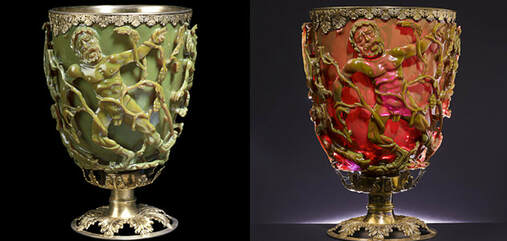
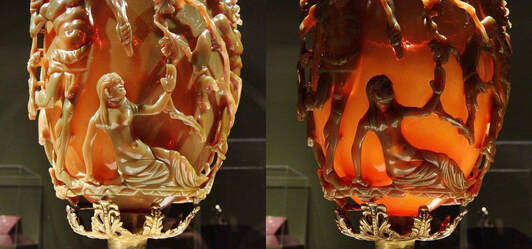























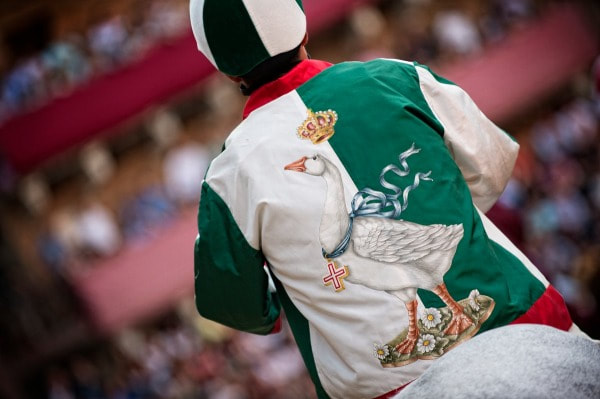









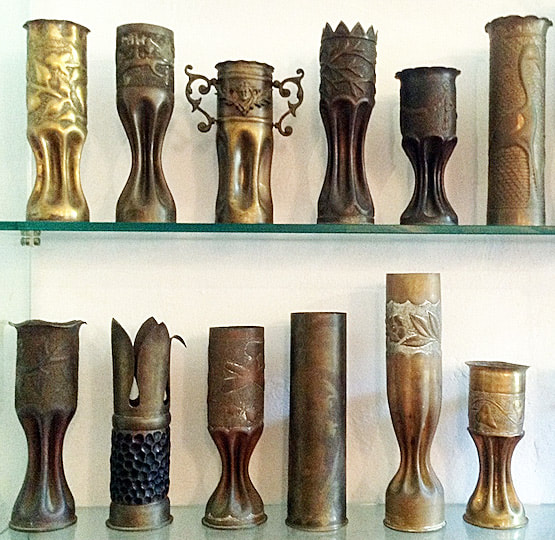






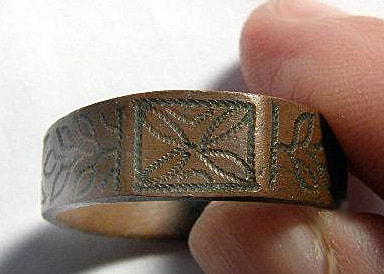
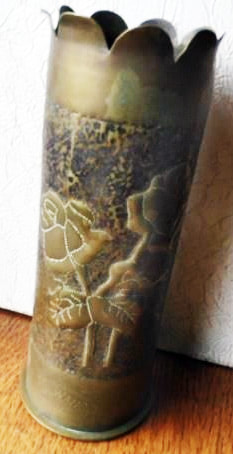

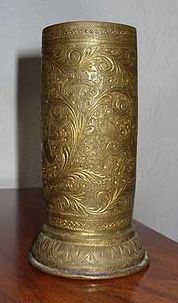



 RSS Feed
RSS Feed
